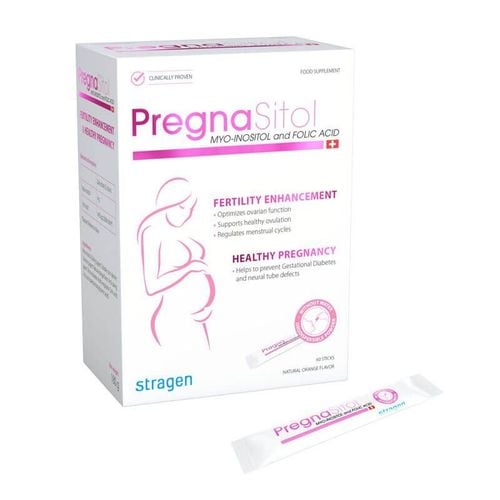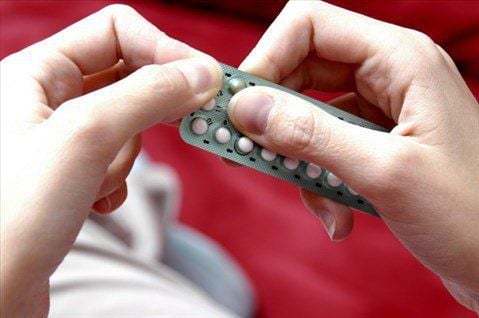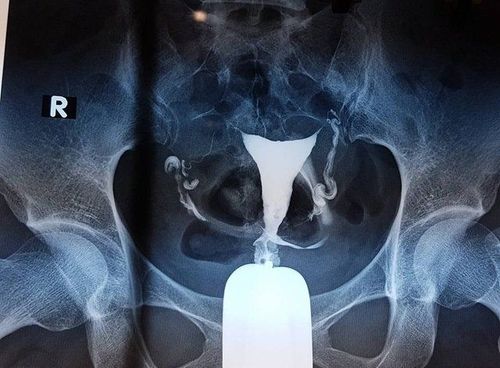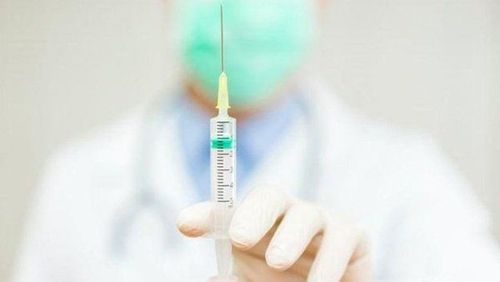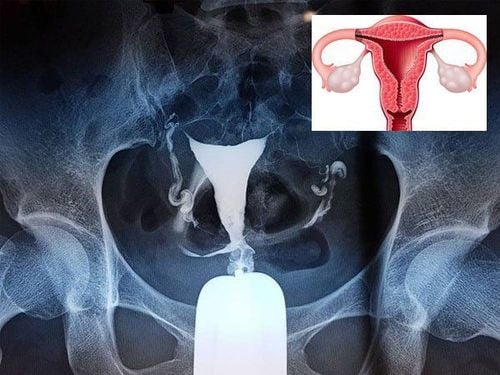This is an automatically translated article.
Hysterosalpingogram (HSG) is an X-ray procedure. HSG helps to look inside the uterus and fallopian tubes and the area around them. Hysterosalpingogram is usually done for women who are having trouble getting pregnant (infertility).
1. What is Hysterosalpingogram (HSG)?
Hysterosalpingogram (HSG) is a test used to examine the uterus and fallopian tubes for problems that may cause infertility. You may have this procedure as part of a routine fertility evaluation, or your doctor may order it if they suspect you have blocked fallopian tubes or some other abnormality in your uterus. bow.
The test may show any blockages that could prevent an egg from reaching the uterus after leaving the ovary. For example, scar tissue from previous abdominal surgery (such as removal of a fibroid) can cause an obstruction. Endometriosis and some sexually transmitted infections (STIs), such as chlamydia and gonorrhea, can also cause scarring that blocks the fallopian tubes.
HSG can also detect abnormalities in the uterus that may prevent a fertilized egg from implanting in the uterine wall. These include scar tissue, polyps, fibroids, or an irregularly shaped uterus.
If blocked fallopian tubes are the cause of infertility, an oil-based dye can be used during HSG to clear the blockage. Some studies show that oil-based dyes can open up clogs better than water-based dyes. Other studies have shown that there is no difference between the two dyes.
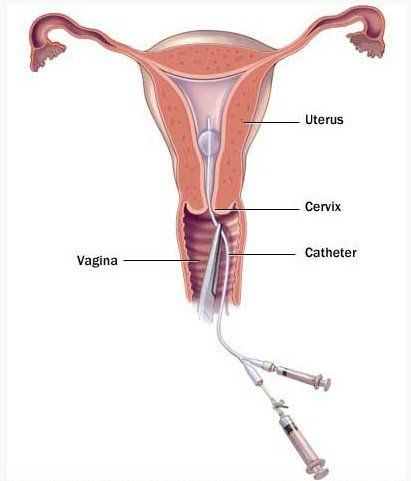
Chụp Hysterosalpingogram cho phép phát hiện những bất thường trong tử cung
2. How is the HSG scan done?
A hysterosalpingogram is usually done by a radiologist in the X-ray room of a hospital or clinic. An X-ray technician and a nurse can help the doctor. A gynecologist or doctor who specializes in examining and treating infertility (reproductive endocrinologist) can also help.
Before the procedure begins, sedation may be given to help the patient relax. In addition, patients can also take ibuprofen to help relax the uterus so that there is no pain during the procedure. You will need to undress below the waist and hang a gown around your waist, while emptying your bladder. You will then lie on your back on an examination table, with your feet lifted and supported by pedals. This allows the doctor to look at the genital area.
During this process, you lie on your back with your feet on the test bench. Your doctor will insert a speculum to hold your vagina open, then insert a thin tube through the opening of your cervix into your uterus. The cervix can be held in place with a clamp called a tenaculum. The cervix is washed with a special soap. A hard tube or a flexible tube is inserted through the cervix into the uterus. The doctor will then remove the speculum and fill your uterus with a liquid containing the dye.
An imaging machine called a fluoroscope is placed on top and uses X-ray technology to create an ultrasound-like image that is projected onto a screen. Your doctor will look for abnormalities as fluid fills the uterus and passes through the fallopian tubes. If they are clear, the fluid will drain near the ovaries and be absorbed by the body. If the fallopian tubes are partially or completely blocked, a buildup of fluid will cause them to bulge near the blockage. After the test, the catheter and speculum are removed. This procedure usually takes 15 to 30 minutes.
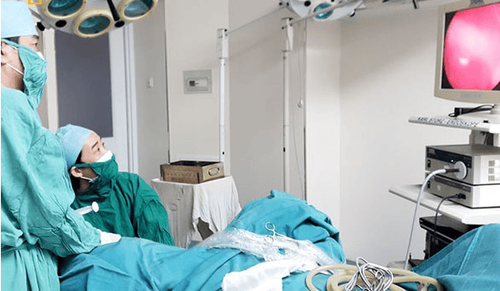
Quy trình chụp HSG
3. What to prepare before taking HSG?
Before the procedure, tell your doctor if you have unexplained vaginal bleeding or are allergic to any foods or medications (especially seafood, iodine, or contrast dyes).
It is important to let your doctor know about (or get checked for) a chronic pelvic infection or an untreated STI. That's because the procedure can push germs from the cervix and vagina through the uterus and fallopian tubes and into the abdomen. This can quickly turn a minor infection into a serious one, so it's better to treat it first.
The best time to schedule a test is a few days to a week after your period ends. If it's done too close to your period, prolonged bleeding can make it harder for your doctor to examine the inside of your uterus. Similarly, if you are tested too close to the start of your period, the thickened lining of the uterus can make it difficult for your doctor to see clearly.
Alternatively, your doctor may ask you not to have sex for a week or so before the test to make sure you're not pregnant. In addition, your doctor may give you sedatives or over-the-counter pain relievers before the procedure to minimize pain, and you may also be prescribed antibiotics to prevent infection. You should arrange to have someone drive you home after the procedure as you may feel a little dizzy or light-headed.

Người bệnh có thể được chỉ định uống thuốc an thần trước khi chụp HSG
4. What to do after HSG scan?
You may experience abdominal pain and vaginal discharge, which may be tinged with blood. The discharge can last for several days as the remaining fluid leaves the body, in which case you should use tampons instead of tampons.
If your fallopian tubes are blocked, your doctor may recommend a surgical procedure to see and possibly clear the tubes. The specific procedure depends on the location and severity of the blockage.
A common possibility is laparoscopy, which uses a slim, light-transmitting camera that is placed through a small incision in your navel. Another method is laparotomy, which is a traditional open surgery performed through a much larger abdominal incision. Both surgeries are performed under anaesthesia. If you cannot clear the blockage, your doctor may recommend you to perform in vitro fertilization.

Bạn có thể sử dụng băng vệ sinh để thấm tiết dịch sau khi chụp HSG
5. Are there any risks with HSG scans?
Serious risks of HSG implementation are rare. Problems often include infection (usually only a risk if you have scarring of your fallopian tubes) or an allergic reaction to the dye.
Signs of infection include:
Bad-smelling discharge Severe abdominal pain Vomiting Heavy vaginal bleeding Fever Signs of an allergic reaction include:
Rash Itching Swelling In addition, there is always a small risk of damage to cells or tissues when exposed to any radiation. This may include the low level of radiation used for this test. The potential for damage from the x-ray is generally very low compared to the possible benefit of the test. Your radiation exposure during the procedure is very low and has not been shown to harm you or your future children, even if you are pregnant in the same month you have it. HSG.
There is a small chance of a pelvic infection after the test. Examples of these are endometritis and fallopian tube inflammation. The risk may be higher for women who have had a previous pelvic infection. Your doctor may prescribe antibiotics if he or she thinks you may have a pelvic infection.

Chảy máu âm đạo là môt rủi ro có thể xảy ra khi chụp HSG
There is a small chance of damaging or puncturing the uterus or fallopian tubes during the procedure. Plus, you run the risk of having an allergic reaction to the iodine dye. This is more common if you are allergic to any shellfish.
In rare cases, if oil-based dyes are used, oil may leak into the bloodstream. This can cause a blockage of blood to part of the lung (pulmonary embolism). But for the most part, this procedure uses a water-based dye. Contact your doctor immediately if you develop any of these signs.
6. Can HSG scans improve fertility?
This procedure is intended to figure out why you are not pregnant, however some women say the procedure itself has actually improved their fertility.
Research results on this topic vary widely: One review analyzed the results of 13 trials involving nearly 2,500 women and found evidence to suggest that HSG was performed with dyes that are soluble in water. The oil may increase your chances of getting pregnant later in life.
The authors note that the quality of the evidence is low and that HSG is not currently used as a treatment for infertility. However, if you have an HSG, the fluid can move and unclog the fallopian tubes, increasing the chances of pregnancy.
Hysterosalpingogram is done mainly for women who are having trouble getting pregnant. Some research suggests that this procedure may help a woman's chances of getting pregnant. That's because the dye can remove mucus plugs, straighten fallopian tubes, and break up thin scar tissue.
Also, there is another test, called a sonogram (SHG), that can be more accurate in diagnosing fibroids or uterine polyps. SHG uses ultrasound to monitor the movement of saline (saline) solution injected into the uterus. SHG does not use X-rays or iodine dyes.
Some early tests to find the cause of infertility may include tests such as semen analysis and blood tests for luteinizing hormone (LH), progesterone, or follicle-stimulating hormone (FSH). If these tests cannot find the cause of infertility, HSG may be performed.
Make sure your doctor knows if you are taking metformin (such as Glucophage) for diabetes or for any other reason, such as polycystic ovary syndrome (PCOS). This is important because it can interact with the dye used in the HSG scan.

Trung tâm hỗ trợ sinh sản IVF Vinmec đã đem lại nhiều niềm vui cho các cặp vợ chồng vô sinh hiếm muộn
Hysterosalpingogram (hysterosalpingogram) is quite simple and safe. This is one of the X-ray tests that effectively support the treatment of infertility and infertility. If you are having problems with infertility and infertility, you can contact Vinmec Fertility Support Center.
This is the leading modern center in Vietnam, built and applied a comprehensive medical examination and treatment process, combining both Southern medicine and Obstetrics and Gynecology to provide the optimal solution for each patient's case. . Up to now, Vinmec IVF Center has performed fertility support for over 1000 infertile couples with a success rate of over 40%. This rate is equivalent to developed countries such as UK, USA, Australia,...
With high professional level and extensive experience, Vinmec's team of experts is capable of deploying. Synchronize and comprehensively the most advanced assisted reproductive techniques today, helping to realize the dream of parenthood of hundreds of families across Vietnam.
Please dial HOTLINE for more information or register for an appointment HERE. Download MyVinmec app to make appointments faster and to manage your bookings easily.
Reference source: babycenter.com




